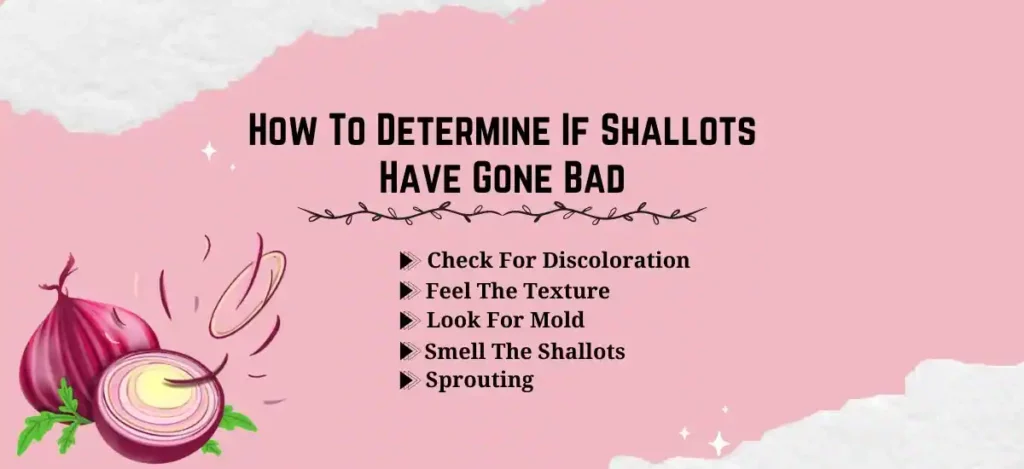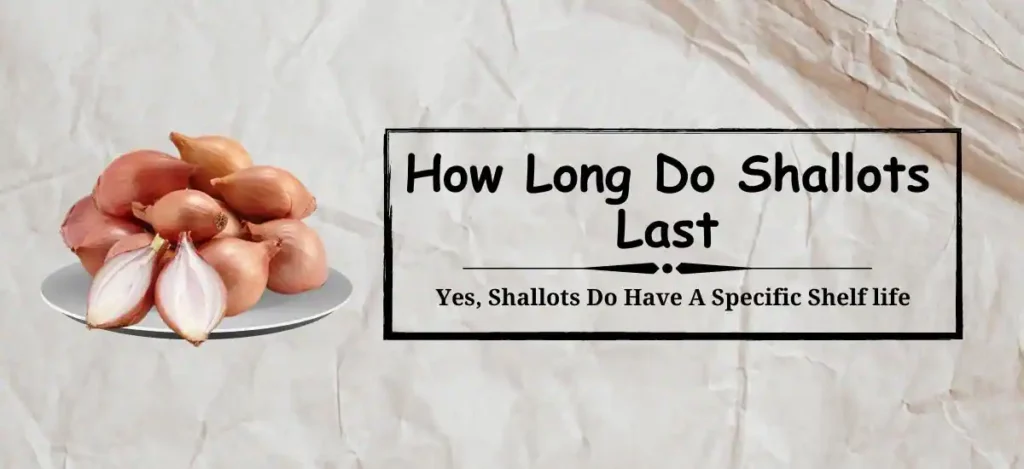Yes, shallots do have a specific shelf life. On average, when stored properly in a cool, dry, and well-ventilated place at room temperature, whole shallots can last up to a month.
Whole, unpeeled shallots have the longest shelf life. Kept in ideal conditions – a cool (not cold), dry, and well-ventilated area out of direct sunlight – these can last for a month or even a little longer. It’s worthwhile noting that if your shallots are very fresh when you buy them (for example, directly from a farmer’s market), their shelf life might be extended a bit.
Storing Shallots: Do’s And Don’ts

Do’s:
- Store In A Cool, Dry, And Dark Environment: Shallots prefer a cool (but not cold), dry, well-ventilated area for storage. A pantry or cupboard can serve well for this purpose.
- Use A Mesh Bag: Store shallots in a mesh or net bag. This allows good air circulation which reduces the chance of molding.
- Store Separately: If possible, store shallots separately from other vegetables. They can absorb moisture and odors from other vegetables which can reduce their shelf life.
- Regularly Check For Spoilage: Regularly checking your shallots will allow you to remove any that have begun to spoil, preventing the spoilage from spreading to the remaining bulbs.
Don’ts:
- Don’t Store In Plastic Bags: Plastic bags do not provide good ventilation and can cause shallots to become moldy and spoil faster.
- Don’t Refrigerate Raw Shallots: Shallots do not need to be refrigerated unless they have been peeled or cut. Refrigeration can cause them to become too moist and they can lose their crisp texture.
- Don’t Store Near Potatoes: Potatoes release gases that can cause shallots (and other onions) to spoil more quickly.
- Don’t Store Them In Sunlight: Direct sunlight can cause shallots to sprout and can shorten their shelf life. Remember, proper storage is key to maximizing the shelf-life of shallots while maintaining their flavor and nutritional benefits.
Preserving Shallots For Longer Shelf Life
- Freezing: If you have a large amount of shallots that you can’t use immediately, consider freezing them. Chop the shallots, spread them out on a baking sheet, and freeze. Once frozen, transfer them into freezer bags or containers. They can last up to 6 months in the freezer.
- Pickling: Pickling shallots is another long-term preservation method. Pickled shallots can be stored in the refrigerator for up to a year.
- Drying: Drying shallots is a great way to preserve them. You can use a food dehydrator or oven to dry them. Once dried, store them in an airtight container in a cool, dark, and dry place.
- Canning: Canning is an effective method for preserving shallots. It involves placing the shallots in a jar with vinegar or a brine solution and then heat processing the jars to seal them.
- Storing in Pantyhose: Putting shallots in the legs of clean, old pantyhose and hanging them in a cool, dry place can extend their shelf life. Make sure to tie knots between each shallot to prevent them from touching each other.
Note: Each method of preservation has its own pros and cons. While freezing and canning preserve the freshness of shallots, they might change their texture. Drying and pickling can alter the taste but provide a unique flavor to dishes. Choose the method that best suits your culinary needs and preferences.
How To Determine If Shallots Have Gone Bad

- Check For Discoloration: Healthy shallots have golden brown or red skin and the flesh inside should be white. If you notice green or dark spots, it might indicate that the shallots have started to go bad.
- Feel The Texture: Fresh shallots should feel firm when lightly squeezed. If the shallots feel soft, mushy, or have a squishy texture, it’s likely that they have spoiled.
- Look For Mold: Mold is a clear sign that your shallots have gone bad. If you see any fuzzy spots or growth on the surface, discard them immediately.
- Smell The Shallots: Fresh shallots have a mild and sweet aroma. If you detect a sour, unpleasant, or off smell, it’s best to throw them away as this is a sign of spoilage.
- Sprouting: While sprouting itself is not a sign of spoilage, if the shallots are sprouting excessively or if the sprouts have a dark color and a rotten smell, it’s time to toss them. Remember, when in doubt, it’s always safer to discard potentially spoiled food. Consuming spoiled shallots can lead to food poisoning or other health issues.
Health Issues When You Eat Expired Shallots
- Food Poisoning: Consuming spoiled shallots can lead to food poisoning symptoms like nausea, vomiting, diarrhea, stomach cramps, and fever.
- Allergic Reactions: Some people might experience allergic reactions from spoiled shallots, which could cause symptoms like swelling, itching, hives, and difficulty breathing.
- Digestive Issues: Eating spoiled shallots can disrupt your digestive system, leading to issues like bloating, indigestion, and discomfort.
- Severe Illness: In some cases, foodborne illnesses from spoiled food can lead to more serious conditions such as kidney failure, chronic arthritis, brain and nerve damage, and even death.
- Dehydration: The vomiting and diarrhea associated with food poisoning can lead to severe dehydration, which can be particularly dangerous for children, the elderly, and those with weak immune systems. Always remember to check your shallots for any signs of spoilage before using them in your meals. If unsure, it’s better to err on the side of safety and discard them.
Shallots vs. Onions: Comparisons In Shelf Life
- Duration: Onions generally have a longer shelf life than shallots. While shallots can last for about a month in appropriate conditions, onions can stay fresh for up to two months, or even longer if stored correctly.
- Storage Requirements: Both shallots and onions require similar storage conditions – cool, dry, and well-ventilated areas. However, onions are slightly more resilient to varying conditions than shallots.
- Refrigeration: Cut onions, like cut shallots, should be refrigerated to extend their shelf life. However, cut onions may last a bit longer in the fridge than cut shallots due to their lower moisture content.
- Signs Of Spoilage: Both shallots and onions show similar signs of spoilage such as mold, unpleasant odor, softness, and discoloration. Onions, however, may sometimes develop a hollow center when they start to spoil, which is not common in shallots.
- Preservation: Both shallots and onions can be preserved using similar methods such as freezing, pickling, or drying. However, due to their delicate flavor, shallots might not retain their taste as well as onions when preserved using these methods.
Tips For Purchasing Fresh Shallots
- Check The Appearance: Fresh shallots should have smooth and unblemished skin. They should be firm to the touch and free from any visible signs of mold, decay, or moisture.
- Smell The Shallots: Fresh shallots have a mild and sweet aroma. Avoid any shallots that have a strong, unpleasant odor, as this could be a sign of spoilage.
- Size Matters: Opt for medium-sized shallots. They are often more flavorful than larger ones, which may be more watered down in taste.
- Avoid Sprouting Shallots: If the shallots have green sprouts shooting out, they are past their prime and the taste will be compromised.
- Consider The Season: Shallots are often freshest and most flavorful during their peak season, which is usually late spring through early fall.
When it comes to where to buy shallots, they are commonly available at most grocery stores, farmer’s markets, and online grocery platforms. Keep in mind, however, that shallots at farmer’s markets are often fresher and more flavorful as they are locally grown and sold soon after harvesting. Also, organic shallots can be a great choice as they are grown without the use of synthetic pesticides and fertilizers.
Frequently Asked Questions
Q1. How Long Do Cooked Shallots Last?
Ans: Cooked shallots, when stored properly in an airtight container, can last up to a week in the refrigerator. However, for optimal freshness and taste, it is recommended to consume cooked shallots within 3-4 days.
Q2. How Long Do Shallots Last at Room Temperature?
Ans: Whole, uncut shallots can last for about a month at room temperature when stored in a cool, dry, and well-ventilated place. However, if the shallots are cut, they will not last as long and should ideally be used within a day or two.
Q3. How Long Do Shallots Last In The Fridge?
Ans: Whole shallots do not need to be refrigerated, and doing so can actually lead to them spoiling faster due to excess moisture. However, if you have cut shallots, they can be stored in the fridge in an airtight container for about a week. Similarly, cooked shallots can be refrigerated for up to a week as well.
Related Post:
